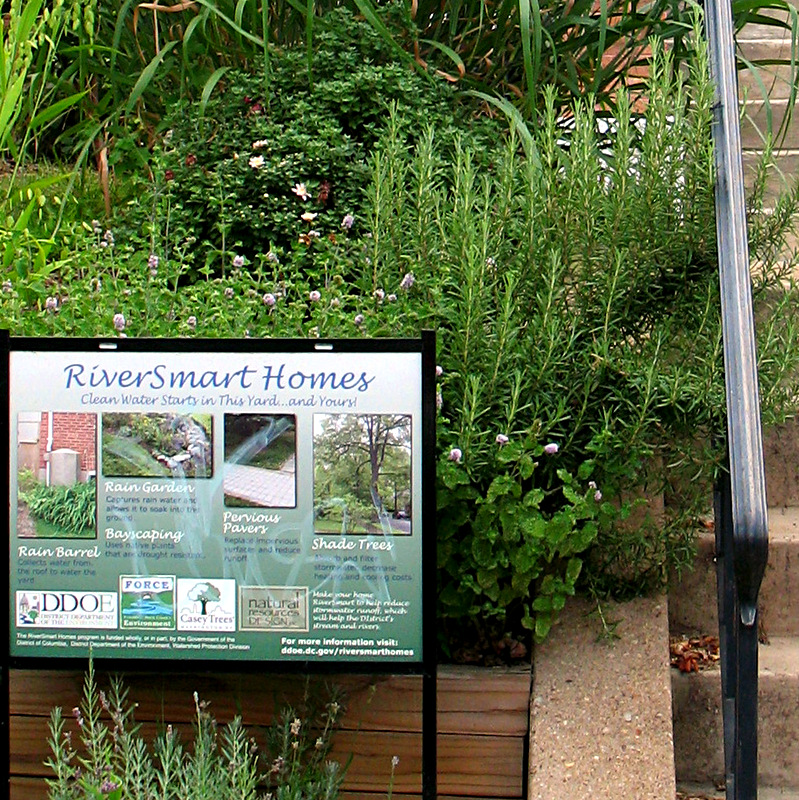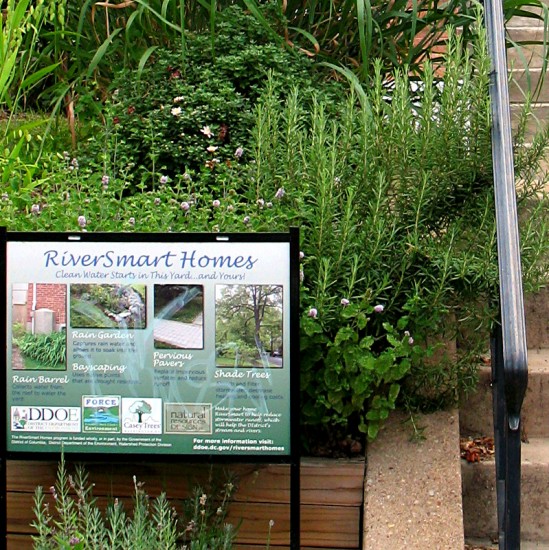Northwest homeowners can take advantage of numerous incentives meant to encourage them to hook a rain barrel to their downspout or channel their roof runoff into a rain garden. Local governments provide residents and businesses cash rebates, do-gooder bragging rights, and discounts on utility bills.
But one of the most interesting incentive programs I’ve heard about so far comes from Washington, DC. The RiverSmart Homes program, which is run by the District of Columbia Department of the Environment, works like the energy audit programs that Northwesterners might be familiar with.
- A homeowner fills out an application online.
- An expert from the DC Department of Environment visits the applicant’s home and conducts an audit identifying where the runoff is coming from.
- The homeowner gets a report suggesting stormwater solutions that could include rain barrels, rain gardens, trees and other vegetation, and permeable pavement, plus the approximate costs of the work.
- The homeowner contacts the department and tells them which items they want.
- The department appoints a certified contractor to schedule a time with the homeowner to do the work.
It’s so blissfully simple!
Homeowners are required to pay approximately 10 percent of the costs and the DC Department of Environment covers up to $1,200 for total stormwater installations per home. For example, a homeowner has to pay $30 of the cost of a rain barrel installation, and the department picks up the rest, which can be up to $300. A homeowner’s co-payment for a rain garden is $75, with the remainder — or up to $1,200 — paid by the department.
RiverSmart Homes is so popular that there’s a waiting list of up to 300 people, and a two to three month wait for an audit.
“On average about 100 homeowners sign up a month and we do not do very much outreach as the program promotes itself by word of mouth,” explained Jennifer Guillaume, with the DC Department of Environment, by email.
Why the overflowing love for the program? I think there are a few reasons.
First, even when you can get stuff practically for free, it’s extra enticing when it’s easy.
Second, the rebates are generous. A $300 rain barrel for $30 sounds sweet to me.
Third, the energy audit approach provides a homeowner with a multitude of personal benefits. While some people will want to sign up because of a desire to help clean polluted runoff that’s damaging local rivers and bays, not everyone has such altruistic motives.
When I did an energy audit and retrofits to my Seattle home last year, I did them because I’m deeply concerned about climate change, but I was also psyched to have a warmer house and lower gas and electric bills. I loved that the audit essentially provided me with a tutorial on how my house works from an energy perspective. It would be great to get that same sort of instruction on stormwater, potentially saving a homeowner from flooded basements, landslides, dry rot, or related water damage. Houses are big scary investments and if an expert can tell me how to operate and protect mine better, that information is valuable to me.
RiverSmart officials began doing pilot projects in 2008, then expanded the program DC-wide in 2009. Since then, they have completed 3,269 audits, according to Guillaume. The program has spent $36,000 on rebates, mostly for trees. RiverSmart has three full-time staff and a budget of $850,000 for installations, which is awarded to nonprofit partners working with the program.
There are Northwest programs similar to the DC incentives, including Seattle’s RainWise program. But the thing that I find so appealing about the DC program is its simplicity for homeowners.
The Seattle program requires residents to do their own soil infiltration test, fill out a more complicated application form that asks you to decide what volume of water you want to treat, then select and contact contractors for bids. The projects require residents to get pre and post inspections from the city. If you’re excited about rain gardens and the like, it could be fun to play around with the software and explore the range of green stormwater solutions available. But if you’re likely to sign up only if it’s slightly more troublesome than placing an order on Amazon, you’ll probably skip the dozen-step process.
That said, RainWise is to thank for the construction of numerous attractive rain-sponging gardens and cisterns that are helping clean up the city’s polluted runoff. And heck, residents are getting something valuable for free or cheap, so asking them to jump through a couple of hoops is pretty reasonable.
Cash-strapped municipalities are forking over money to pay for these private projects because polluted stormwater is a huge problem nationwide. DC, Seattle, Portland and municipalities everywhere are struggling to find the most cost-effective, efficient ways to keep filthy runoff and sewage waste out of local water bodies. Research shows that green installations can be a smart investment towards reaching those goals, and that includes rain gardens and other projects on private property.
Just as runoff and the toxic chemicals that foul it come from infinite sources, the solutions are going to need to come from every direction as well — including ideas from across the nation.
Note: This post was updated October 31 at 11:45 a.m. with stats on the program and comment from Jennifer Guillaume.












David Hymel
Excellent article Lisa. I am wondering if this could this be the next evolution of Seattle’s RainWise program and a model for other jurisdictions exploring successful cost share initiatives.
Heather Phipps
This is a great article and I am glad the two Washingtons can share ideas! I really agree with your point that solutions to our stormwater problems in this country are going to need to come from many directions.
Aaron Clark
Thanks for sharing Lisa. The D.C. program is another good example. Some advantages that we have through RainWise though include: rebates often totaling $4,000-$5,000 per home and a choice of contractors (rather than having the city choose for us). It can be a tricky process to navigate, but a few local NGOs including ourselves, are available to help make it easier. We even do site visits similar to the River Smart audits. Definitely there are some good ideas in the River Smart program that could be adopted here.
Lisa Stiffler
Thanks, Aaron for adding more info on RainWise. It’s great the city is offering up to $5,000! And a point of clarification, DC will allow homeowners to choose their own contractors, but it adds another step to the process.